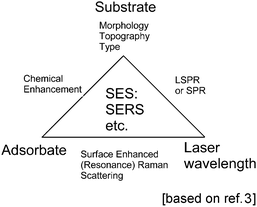Surface-enhanced spectroscopies
Rudolf
Holze
*a and
Sebastian
Schlücker
*b
aTechnische Universität Chemnitz, Institut für Chemie, AG Elektrochemie, 09107 Chemnitz, Germany. E-mail: rudolf.holze@chemie.tu-chemnitz.de
bUniversität Duisburg-Essen, Fakultät für Chemie, Physikalische Chemie I, AG Nanobiophotonik, 45141 Essen, Germany. E-mail: sebastian.schluecker@uni-due.de
In this journal previously, an overview on plasmonics and spectroscopy has been provided dealing with a subset of the methods and phenomena covered in the present issue; for an introduction, see ref. 4. On the occasion of a recent conference, Surface-Enhanced Spectroscopies 2014 (SES 2014) (Chemnitz, Technische Universität Chemnitz, August 7th–10th, 2014), an attempt was made to cover the field from fundamentals and modelling to applications in numerous fields. Starting with this survey, the editors of this themed issue have collected contributions covering the range of the topic beyond this conference.
Thanks are due to the reviewers executing their work in the background providing helpful suggestions and constructive criticism to the authors. Thanks are due to the editorial staff handling this issue in a time of transformation at the editorial office, and thanks are due to the Deutsche Bunsen-Gesellschaft für Physikalische Chemie providing the initial input to assemble this issue. The assistance in various ways (including a financial one by several organizations DFG, RSC, TUC and further companies) and by many supporting people is gratefully acknowledged.
References
- A. Hartstein, J. R. Kirtley and J. C. Tsang, Phys. Rev. Lett., 1980, 45, 201 CrossRef CAS.
- M. Fleischmann, P. J. Hendra and A. J. McQuillan, Chem. Phys. Lett., 1974, 26, 163 CrossRef CAS.
- M. Culha, Appl. Spectrosc., 2013, 67, 355 CrossRef CAS PubMed.
- R. F. Aroca, Phys. Chem. Chem. Phys., 2013, 15, 5355 RSC.
| This journal is © the Owner Societies 2015 |

